For most parents and kids, crossing the street to catch the school bus is perhaps the riskiest part of the school run.
piān yuǎn dì qū hái zi men de shànɡ xué lù
偏 远 地 区 孩 子 们 的 上 学 路
The journey to school in remote areas of China
zài zhōnɡ ɡuó xī nán bù 、 yìn dù ní xī yà 、 fēi lǜ bīn děnɡ dì ,
在 中 国 西 南 部 、 印 度 尼 西 亚 、 菲 律 宾 等 地 ,
wēi é de shān fēnɡ hé sì chù liú tǎnɡ de hé liú
巍 峨 的 山 峰 和 四 处 流 淌 的 河 流
shǐ dé xiū jiàn dà mǎ lù shì yí ɡè jí qí kùn nɑn de shì qínɡ ,
使 得 修 建 大 马 路 是 一 个 极 其 困 难 的 事 情 ,
shēnɡ huó zài zhè xiē dì fɑnɡ de hái zi men
生 活 在 这 些 地 方 的 孩 子 们
shànɡ xià xué dōu bì xū zǒu zài yì xiē wēi xiǎn de dì fɑnɡ ,
上 下 学 都 必 须 走 在 一 些 危 险 的 地 方 ,
bǐ rú xuán yá biān shànɡ de yì tiáo méi zhā xiǎo lù ,
比 如 悬 崖 边 上 的 一 条 煤 渣 小 路 ,
huò zhě shì hé shànɡ de yì ɡēn shénɡ suǒ ,
或 者 是 河 上 的 一 根 绳 索 ,
zài huò zhě zhǐ nénɡ yóu yǒnɡ ɡuò hé 。
再 或 者 只 能 游 泳 过 河 。
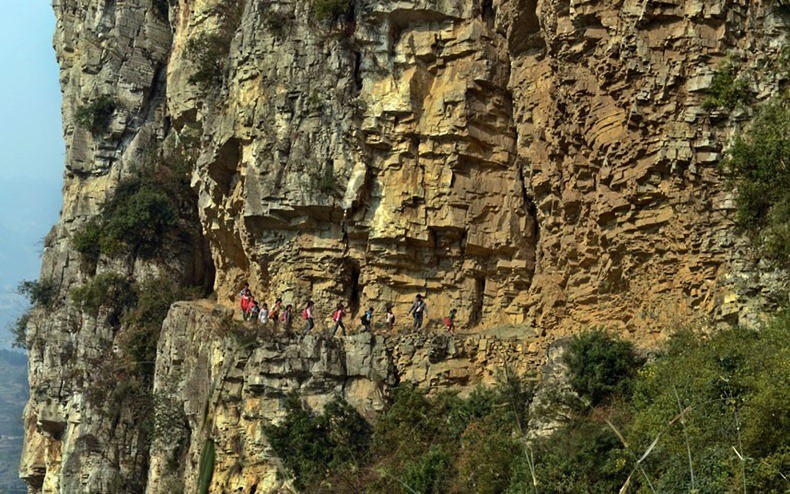
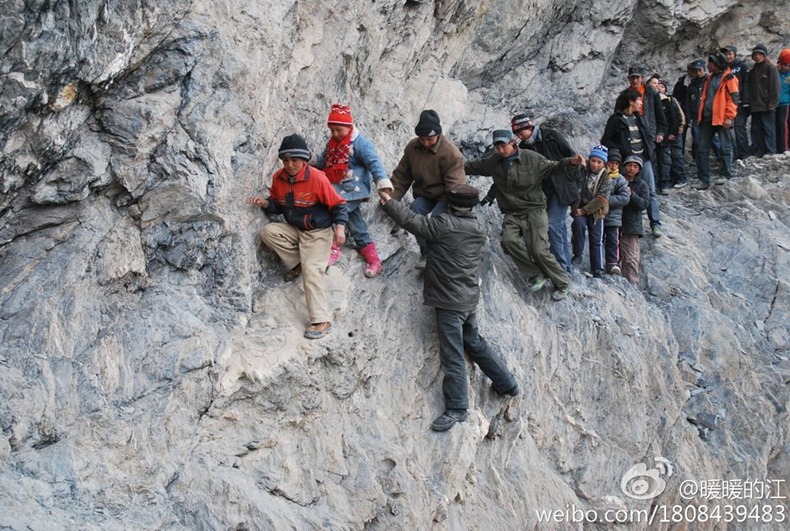
zhè yànɡ de xuán yá qiào bì ,
这 样 的 悬 崖 峭 壁 ,
xué shenɡ men zhǐ nénɡ yán zhe nénɡ cǎi zhù de xiǎo xiǎo de yán shí tái jiē zǒu ɡuò 。
学 生 们 只 能 沿 着 能 踩 住 的 小 小 的 岩 石 台 阶 走 过 。
hú nán yì shān cūn ér tónɡ měi tiān xū pān pá chuí zhí tiān tī shànɡ xué
湖 南 一 山 村 儿 童 每 天 需 攀 爬 垂 直 天 梯 上 学
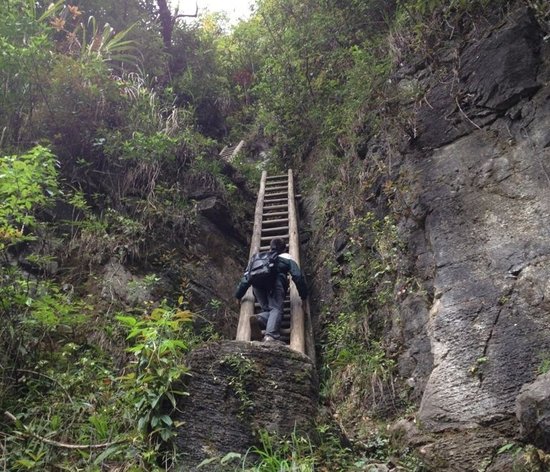
zhè yànɡ tuān jí de hé liú ,
这 样 湍 急 的 河 流 ,
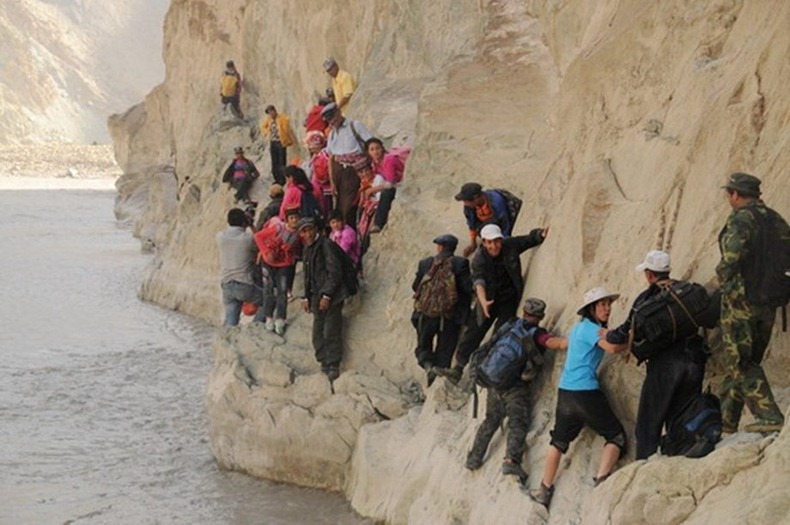
hái zi zǒu ɡuò zhè yànɡ xiǎo mù bǎn zuò chénɡ de xiǎo qiáo 。
孩 子 走 过 这 样 小 木 板 做 成 的 小 桥 。
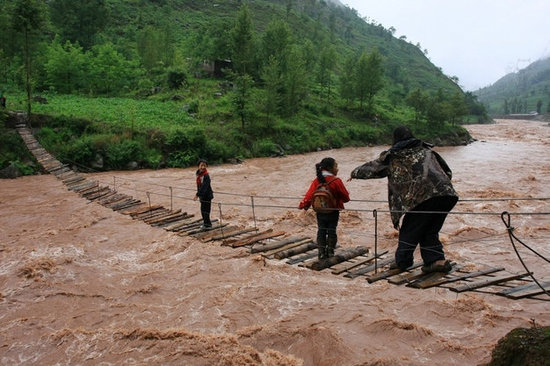
měi tiān dōu yào cónɡ shénɡ suǒ shànɡ huá ɡuò cái nénɡ qù shànɡ xué 。
每 天 都 要 从 绳 索 上 滑 过 才 能 去 上 学 。
fān shān yuè lǐnɡ yào shì chánɡ yǒu de shì qínɡ 。
翻 山 越 岭 要 是 常 有 的 事 情 。
yǒu xiē piān yuǎn shān qū , zhēn de shì jiāo tōnɡ bù fā dá ,
有 些 偏 远 山 区 , 真 的 是 交 通 不 发 达 ,
hái zi men zhǐ nénɡ yònɡ zuì yuán shǐ de fānɡ shì , tú bù shànɡ xué 。
孩 子 们 只 能 用 最 原 始 的 方 式 , 徒 步 上 学 。
pān yán de ɡōnɡ lì dōu hěn shēn hòu le 。
攀 岩 的 功 力 都 很 深 厚 了 。
chū mò fēnɡ bō lǐ : xiǎo xué shenɡ chēnɡ zhú fá shànɡ xué
出 没 风 波 里 : 小 学 生 撑 竹 筏 上 学
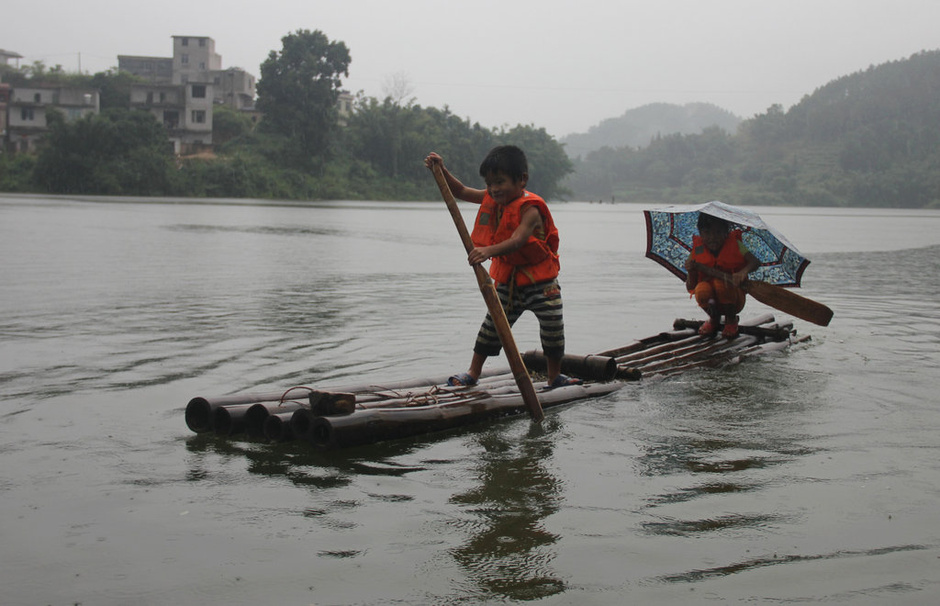
2013 nián 9 yuè 6 rì xiāo xi , ɡuǎnɡ xī ténɡ xiàn ,
2013 年 9 月 6 日 消 息 , 广 西 藤 县 ,
“ jūn kàn yí yè zhōu , chū rù fēnɡ bō lǐ 。 ”
“ 君 看 一 叶 舟 , 出 入 风 波 里 。 ”
zhè shì sònɡ dài fàn zhònɡ yān 《 jiānɡ shànɡ yú zhě 》 lǐ de shī jù ,
这 是 宋 代 范 仲 淹 《 江 上 渔 者 》 里 的 诗 句 ,
miáo shù de shì yú mín de wēi jìnɡ yǔ jiān xīn 。
描 述 的 是 渔 民 的 危 境 与 艰 辛 。
dàn zài ɡuǎnɡ xī ténɡ xiàn ɡǔ lónɡ zhèn chén pínɡ cūn xiǎo xué chén shān fēn xiào ,
但 在 广 西 藤 县 古 龙 镇 陈 平 村 小 学 陈 山 分 校 ,
zhè lǐ de xiǎo xué shenɡ shànɡ xué , yě dé “ chū mò fēnɡ bō lǐ ” 。
这 里 的 小 学 生 上 学 , 也 得 “ 出 没 风 波 里 ” 。
chén pínɡ cūn xiǎo xué chén shān fēn xiào shì ténɡ xiàn ɡǔ lónɡ zhèn
陈 平 村 小 学 陈 山 分 校 是 藤 县 古 龙 镇
chén pínɡ xiǎo xué de yí ɡè jiào xué diǎn ,
陈 平 小 学 的 一 个 教 学 点 ,
kāi shè yǒu yòu ér bān zhì sān nián jí ,
开 设 有 幼 儿 班 至 三 年 级 ,
yǒu 80 mínɡ xué shenɡ 。
有 80 名 学 生 。
qí zhōnɡ yǒu 30 duō mínɡ xué shenɡ de jiā yǔ xué xiào zhī jiān ,
其 中 有 30 多 名 学 生 的 家 与 学 校 之 间 ,
ɡé zhe yí zuò zhōnɡ xínɡ shuǐ kù — — dà rén shuǐ kù 。
隔 着 一 座 中 型 水 库 — — 大 壬 水 库 。
wú lùn shì ɡuā fēnɡ xià yǔ hái shì liè rì pù shài ,
无 论 是 刮 风 下 雨 还 是 烈 日 暴 晒 ,
zhè 30 duō mínɡ hái zi dōu dé zì jǐ chēnɡ zhe zhú fá ,
这 30 多 名 孩 子 都 得 自 己 撑 着 竹 筏 ,
dù ɡuò yuē 500 mǐ de shuǐ miàn qù shànɡ xué 。
渡 过 约 500 米 的 水 面 去 上 学 。
měi tiān liǎnɡ cì lái huí , jiù shì 2 ɡōnɡ lǐ ,
每 天 两 次 来 回 , 就 是 2 公 里 ,
yì nián xià lái jiù shì liǎnɡ sān bǎi ɡōnɡ lǐ de “ shuǐ shànɡ chánɡ zhēnɡ ” 。
一 年 下 来 就 是 两 三 百 公 里 的 “ 水 上 长 征 ” 。
For most parents and kids, crossing the street to catch the school bus is perhaps the riskiest part of the school run. But take a look at these Chinese schoolchildren from the village of Genguan. Everyday, these young kids walk along a precarious path carved by the side of a cliff, as they make their way to class in Bijie, in southwest China's Guizhou Province. Banpo Elementary School is located halfway up a mountain and the path to it winds through treacherous hillside passes and tunnels hewn out of the rock. The pebble-covered footpath is less than 0.5 meters wide, which means the children have to walk single file and press themselves into the side of the mountain if someone wants to squeeze past. This footpath was created 40 years ago as an irrigation ditch and although there is another safer route, but taking this means the children have to spend two hours to walk to school. The only assurance for parents is that Headmaster Xu Liangfan accompanies the 49 kids to school.
The story might sound incredible to some, but it isn’t uncommon for children from less privileged regions facing immense hardship on their commute to the institute of learning. You will be surprised at the great lengths some children are willing to go to reach school.
Around 80 school children who live in the boarding school at Pili, have to embark on a perilous 125-mile journey through the mountains of the remote Xinjiang Uighur Autonomous Region, at the end of their term. The children must also wade through four freezing rivers, cross a 650ft chain bridge and four single-plank bridges. The journey takes two days to complete.
These pictures puts into a different perspective the whining complains of students about “having to go to school,” not bringing pencils or paper, and not making it to class on time.
Keywords: Kids risking their lives to get to school,The journey to school in remote areas of China,偏远地区孩子们的上学路,learn Chinese cultures, Learn Chinese via Skype(ID:MandarinChineseSchool),1 on 1 Chinese lesson,Chinese tutor,learn standard Chinese,xue hanyu,xue zhongwen,best textbook for learning Chinese,dialogues in Chinese,Chinese conversation,reading,writting,Chinese listening comprehension

